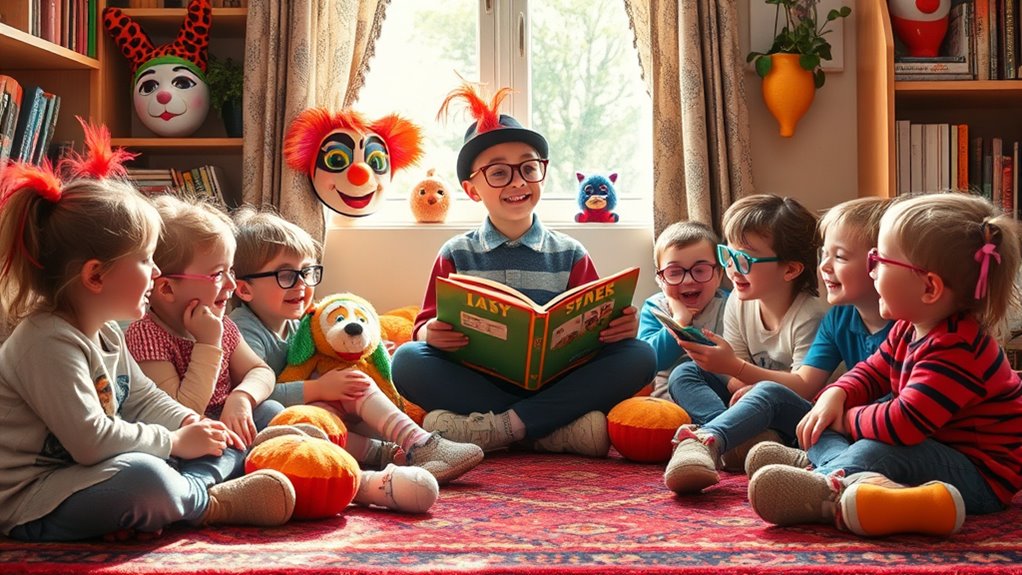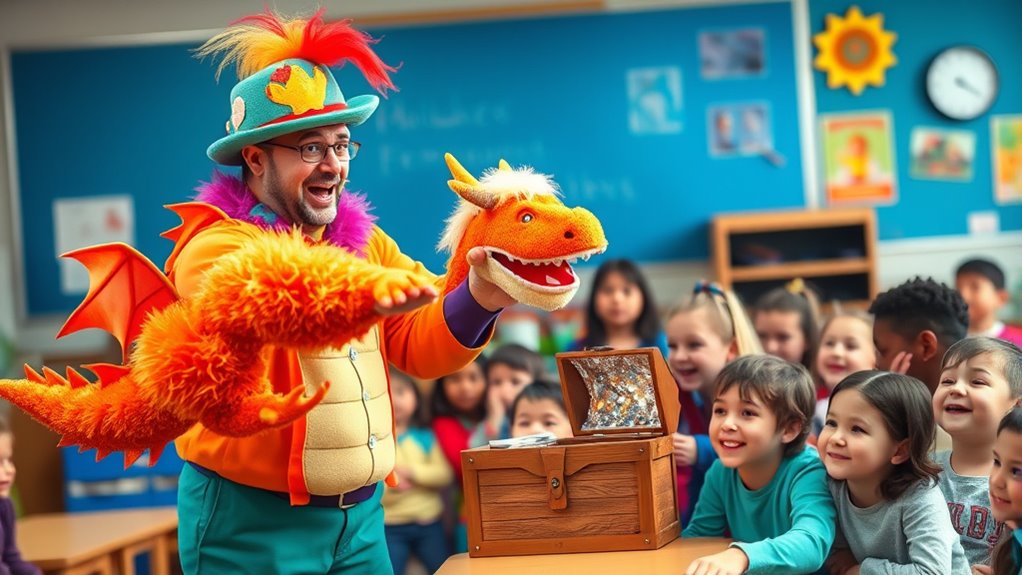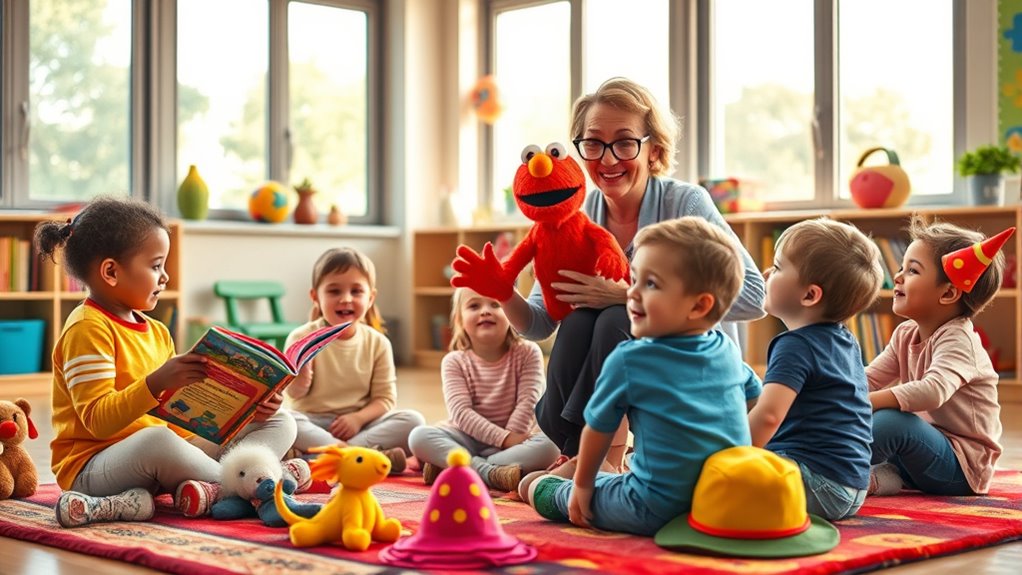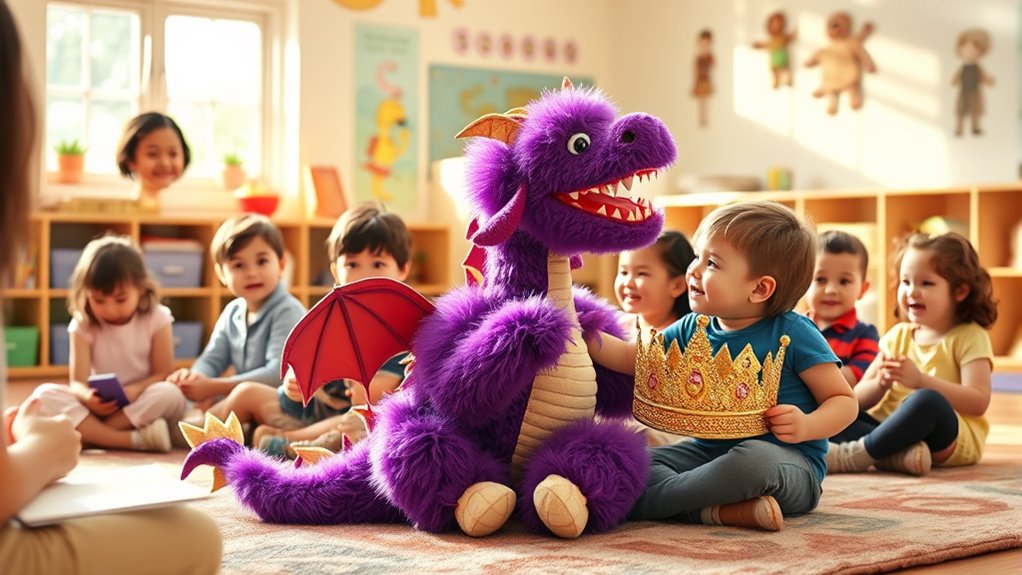To make storytime fun, choose simple props and costumes that match key story elements and help kids visualize characters or settings. Use silly voices to bring characters to life and incorporate sound effects like animal noises or ambient sounds for excitement. Ask interactive questions to engage children’s imaginations, and craft DIY decorations for a personal touch. Keep energy high with movement and vary your techniques—continue reading to discover even more ways to captivate young listeners.
Key Takeaways
- Use themed props and costumes to visually engage children and bring story characters to life.
- Experiment with silly and exaggerated voices to make characters memorable and increase participation.
- Incorporate sound effects like animal sounds or environmental noises for immersive storytelling.
- Encourage children to wear costumes or create DIY props to foster creativity and active involvement.
- Ask open-ended questions and prompt imaginative responses to deepen engagement and make storytime interactive.
Choosing the Right Props to Enhance the Story

Have you ever noticed how the right props can make a story come alive? When you focus on storytelling techniques, prop selection becomes a powerful tool to engage your audience. Choose props that match key story elements and help visualize characters or settings. For example, a simple hat or stuffed animal can represent a character, while a colorful scarf can symbolize a magical object. Think about the story’s mood and message, then select props that enhance those themes. Avoid clutter—select only what’s essential to support the narrative. Using well-chosen props makes your storytelling more dynamic and memorable. It encourages participation, sparks imagination, and makes your storytime truly immersive for everyone involved. Additionally, considering color accuracy in your props can help better convey emotions and atmosphere, making the storytelling experience even more vivid. Paying attention to decorative details can further enrich the visual storytelling and captivate your audience.
Bringing Characters to Life With Voice Play

Ever wonder how to make your story characters truly unforgettable? Voice play is your secret tool for dynamic character development. By experimenting with different voices, you add depth and personality that captivate your young audience. Use exaggerated tones for brave heroes or silly voices for comic sidekicks, making each character distinct. This not only keeps kids engaged but also helps them understand character traits better. As you bring characters to life, you can introduce plot twists through voice changes—shifting from excitement to suspense—keeping children curious and enthusiastic to hear what happens next. Voice play transforms reading from a passive activity into an interactive adventure, making characters memorable and stories more engaging. It’s a simple way to add layers of fun and surprise to your storytime sessions. Additionally, incorporating seasonal variations can enhance the experience by matching voices to different times of year or themes. Exploring voice versatility can further expand your storytelling toolkit, allowing you to adapt to various stories and audiences. Being aware of story structure can also help you craft more compelling and cohesive narratives. Furthermore, understanding prophetic dreams can inspire creative storytelling ideas, adding a mystical or moral dimension to your tales. Incorporating yoga techniques such as mindful breathing can help you stay relaxed and focused during energetic storytelling, making your delivery even more captivating.
Incorporating Sound Effects for Extra Excitement

Adding sound effects can make your storytime more engaging and lively. You might start by including animal sounds to bring characters to life or add environment effects to set the scene. These simple touches can turn a good story into an unforgettable experience. Incorporating sensory stimulation into your storytelling atmosphere can also enhance the sensory experience and make the session even more memorable. Using sound design techniques can help you create a richer auditory environment that captivates your audience and adds depth to your storytelling. Incorporating market volatility insights can also help you understand how changing conditions might influence the effects you choose, ensuring your sounds remain relevant and impactful. Utilizing website performance metrics can help you understand which sound effects resonate most with your audience, allowing you to tailor your storytelling for maximum engagement.
Subheading 1: Enhance With Animal Sounds
Want to make storytime more engaging? Incorporate animal sounds and silly voices to bring stories to life. When you imitate animal sounds, you create excitement and help kids connect with the story. Use playful tones and exaggerated sounds to keep their attention. For example, growling like a bear or chirping like a bird adds fun and encourages participation. To inspire you, here’s a quick guide:
| Animal | Sound Effect |
|---|---|
| Lion | Roar! |
| Duck | Quack! |
| Monkey | Oo Oo Aa Aa! |
| Cat | Meow! |
These sounds make storytime interactive and lively. Kids love the silly voices and will ardently join in, making reading a memorable adventure. Incorporating sound effects techniques can also add a touch of creativity and variation to your storytelling sessions, making them even more memorable.
Subheading 2: Use Environment Effects
To make storytime even more immersive, incorporate environment sounds that complement the story’s setting. Using subtle background music or nature sounds can transport your child into the story’s world. You can also enhance the atmosphere with ambient lighting that matches the scene, like soft glows for nighttime or bright colors for a sunny day. Adding sound effects creates excitement and helps focus attention. Here are some ideas:
- Play gentle background music that sets the mood for the scene
- Use ambient lighting to reflect the story’s environment
- Incorporate sound effects like rain, birds, or city sounds at key moments
- Consider portable audio devices to easily add and control sound effects during storytime
Engaging with cultural storytelling techniques can further enrich the experience by introducing diverse sounds and themes. These touches make storytime more engaging and memorable, turning reading into an interactive adventure. Performance cookies can help you analyze how well these enhancements are working to improve your child’s engagement. Additionally, integrating sound effect apps or devices can streamline the process and ensure seamless playback during your storytelling session. Utilizing sound technology such as speakers or headphones can enhance the clarity and immersion of the sound effects, making the experience even more captivating.
Using Costumes and Dress-Up Items to Engage Kids

Costumes and dress-up items are powerful tools for capturing kids’ imaginations and encouraging active participation in storytime. When you incorporate costume ideas and dress-up accessories, you make the story come alive. Kids love slipping into costumes that match characters, whether it’s a brave knight, a clever princess, or a mischievous animal. These items turn passive listening into dynamic engagement. Use simple dress-up accessories like hats, capes, or masks to enhance storytelling, allowing children to embody characters and explore different perspectives. Not only does this boost their creativity, but it also helps them connect emotionally with the story. Keep costumes easy to put on and take off, so kids can quickly shift between characters and stay immersed in the adventure.
Creating Interactive Questions and Prompts During Reading

Asking thoughtful questions during reading keeps kids engaged and encourages critical thinking. Prompt them to imagine what might happen next or share their own ideas about the story. These interactions make storytime more lively and help children develop their creativity and understanding.
Asking Thought-Provoking Questions
Have you ever wondered how asking questions during reading can deepen understanding and engagement? Thought-provoking questions encourage kids to analyze story details, connect with characters, and consider morals. When you pose questions like “What would you do in this situation?” or “Why do you think the character acted that way?”, you help children grasp moral lessons and character development more deeply. To make this effective, try these strategies:
- Pause and ask open-ended questions about character choices
- Encourage kids to predict future events
- Discuss the lessons characters learn and how they relate to real life
These prompts turn reading into an active conversation, fostering critical thinking while making the story more meaningful and memorable.
Prompting Imaginative Responses
Ever wonder how to make storytime more lively and engaging? Prompting imaginative responses is a powerful storytelling technique that sparks creativity and deepens understanding. As you read, ask open-ended questions like, “What do you think happens next?” or “How would you feel if you were that character?” These prompts encourage kids to picture the story and develop characters’ personalities. By guiding their responses, you help them explore character development and imagine new story possibilities. Incorporate props or silly voices to make these questions more fun. This interactive approach keeps children actively involved, making reading a dynamic experience. Engaging their imagination through thoughtful prompts transforms storytime into an exciting adventure that nurtures both comprehension and creativity.
Crafting Simple DIY Props for a Personal Touch

Creating simple DIY props can add a personalized touch to your storytime experience, making it more engaging and memorable. These DIY decorations enhance storytelling techniques by bringing characters and scenes to life. You don’t need fancy supplies—just some basic craft materials and creativity. For example, you can make paper puppets, felt masks, or cardboard cutouts relevant to your story. These props help kids visualize the story, making it more interactive. Plus, involving children in crafting their own props can boost their enthusiasm and understanding. Keep it simple and fun. Remember, the goal is to complement your storytelling, not to overwhelm it. With a few easy DIY decorations, your storytime will become a lively, personal adventure that kids will remember.
Tips for Maintaining Energy and Keeping Kids Engaged

Adding DIY props to your storytime can make the experience more immersive, but keeping kids energized and engaged requires some extra effort. Use lively storytelling techniques, such as varying your voice and adding silly sounds, to hold their attention. Incorporate movement breaks and interactive questions to keep energy levels high. Engagement strategies like encouraging kids to mimic characters or act out parts of the story make the experience dynamic. Keep your tone enthusiastic and anticipate their reactions, adjusting your pace if you notice waning interest. Remember, the goal is to make reading a lively adventure, so stay flexible and responsive. With these tips, you’ll create a memorable, energetic storytime where kids stay focused and excited from start to finish.
Frequently Asked Questions
How Can I Adapt Props for Different Age Groups?
When adapting props for different age groups, you should consider age-appropriate props that match their developmental stage. For young children, use sensory adaptations like textured or colorful items to engage their senses. For older kids, incorporate more detailed or interactive props to challenge them. Always tailor your props to keep the children engaged and guarantee safety, making the story more immersive and enjoyable for everyone involved.
What Are Some Easy Ways to Incorporate Humor Into Voices?
Ever wonder how to bring a little extra sparkle to storytime? You can easily incorporate humor with funny voice techniques, making characters come alive with humorous character voices. Use simple tricks like exaggerated pitches, funny accents, or unexpected pauses. Play around with silly sounds and expressions, and don’t be afraid to be playful. These lighthearted approaches will keep kids engaged and make reading fun for everyone, creating memorable storytelling moments.
How Do I Balance Props With Traditional Storytelling Techniques?
To balance props integration with traditional storytelling techniques, focus on seamless progressions that enhance your narrative without overwhelming it. Use props strategically to highlight key moments, keeping your storytelling pacing smooth. Avoid overusing props, so your voice and gestures remain central. Practice blending props naturally into your story, ensuring they support rather than distract from your storytelling. This way, you create an engaging experience that feels lively yet cohesive.
What Are Quick Strategies to Recover if Kids Lose Interest?
When kids lose interest, quick engagement is key. You can re-engage them by changing your tone, using lively voices, or introducing a fun prop suddenly. Ask an exciting question related to the story or let them predict what happens next. These simple interest re-engagement techniques make storytelling dynamic and help bring their focus back. Keep it energetic and responsive, showing enthusiasm to spark their curiosity again.
How Can Props Support Children With Learning Disabilities?
Props can support children with learning disabilities by enhancing sensory integration and providing emotional support. You can use textured or visual props to stimulate their senses, helping them focus and process information better. These tools also offer comfort and reassurance, making the reading experience more engaging and less intimidating. By incorporating appropriate props, you create a supportive environment that encourages participation and boosts confidence in children with diverse learning needs.
Conclusion
By choosing the right props, bringing characters to life with playful voices, incorporating fun sound effects, and engaging kids with costumes and prompts, you create a reading experience that’s lively, interactive, and memorable. Keep the energy high, stay creative, and embrace the joy of storytelling. When you make reading fun, you foster curiosity, spark imagination, and build lasting connections. So, keep experimenting, keep laughing, and keep turning reading into an exciting adventure every time.










